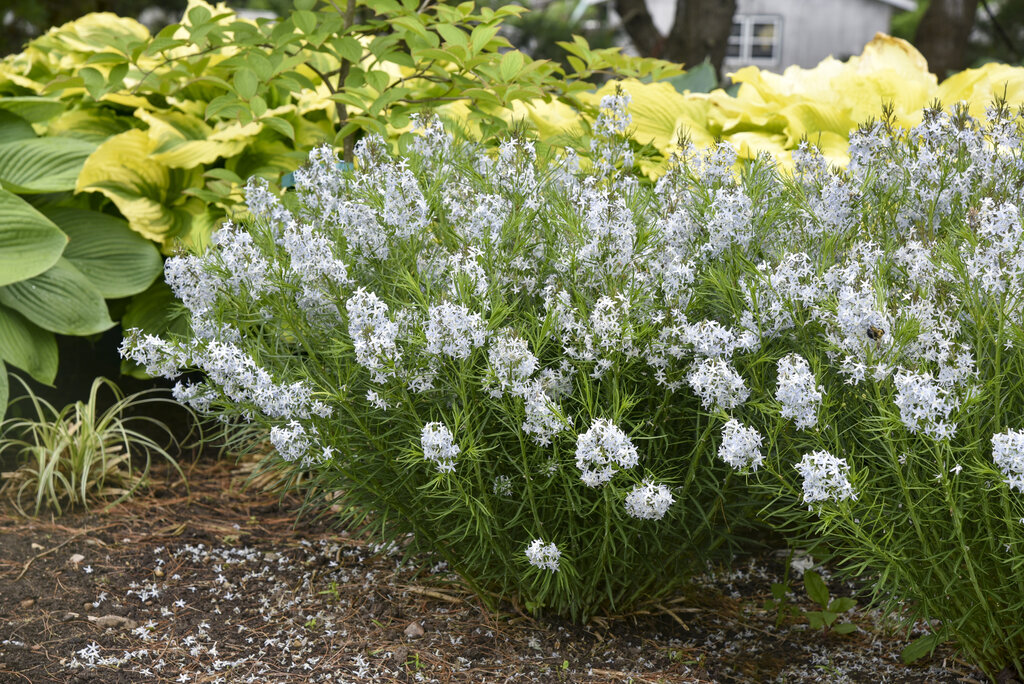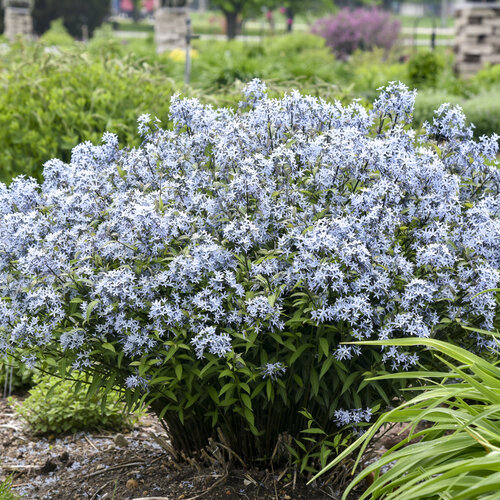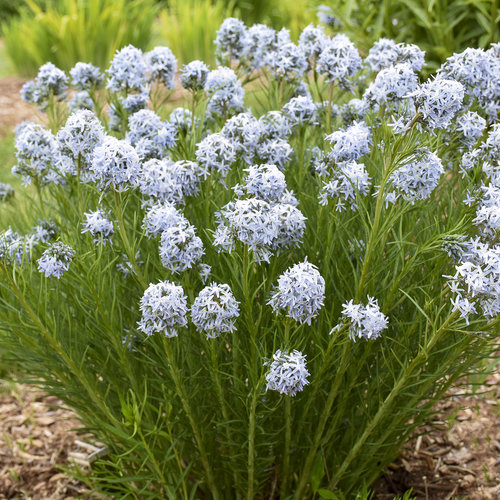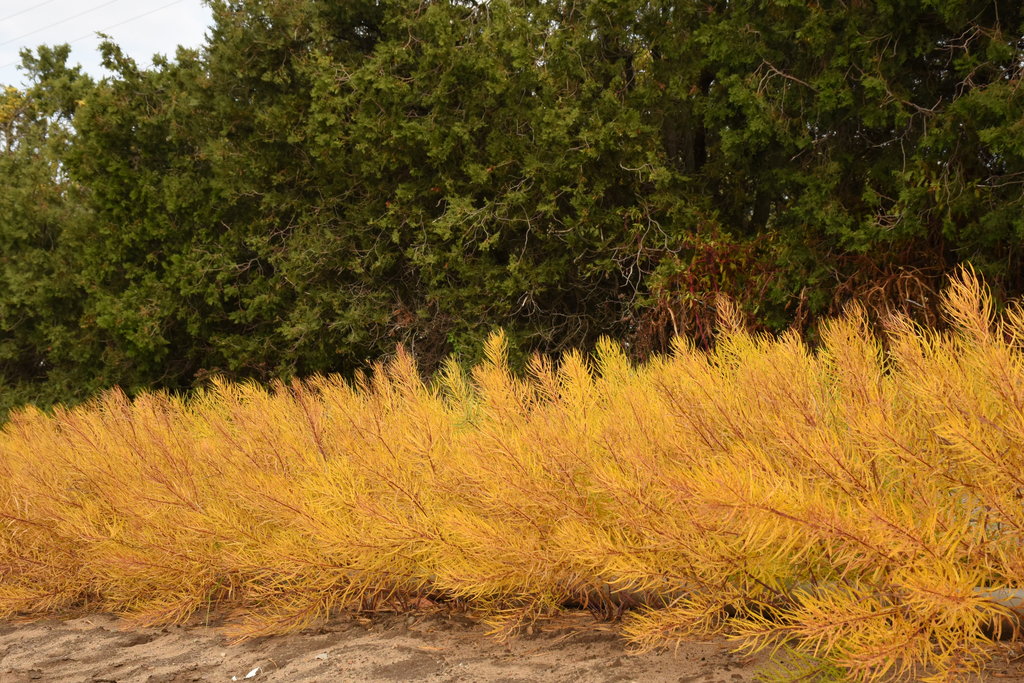Amsonia - The Ultimate Growing Guide from Proven Winners®
Sky-blue flowers and golden-yellow fall color make this native perennial a star in any garden
 Buy amsonia plants - order online and have them shipped right to your door
Buy amsonia plants - order online and have them shipped right to your door
Amsonia, also known by the common name of blue star, is a herbaceous perennial named for the clusters of pale blue star-like flowers that occur from late spring to early summer. Native to North America, blue star is found growing in moist woodlands, meadows and thickets. Upright clump-forming plants produce dense green foliage that turns golden yellow in fall for multi-season appeal.
Two of the most commonly grown amsonia species include eastern blue star (Amsonia tabernaemontana), which produces willow-like leaves, and Arkansas blue star (Amsonia hubrichtii), which has feathery needle-like foliage. Amsonia prefers full sun to part shade and rich, well-draining soil. Plants tolerate a range of growing conditions and are virtually carefree once established. Blue star plants grow 2 to 3 feet tall and 2 to 3 feet wide, with a compact shrubby habit that is suitable for small spaces.
PLANTING & AMSONIA CARE
How to plant: Choose a site with full sun to partial shade and well draining soil. Follow these steps and space plants 2 to 3 feet apart.
- Loosen soil in the planting area and amend with organic matter to add nutrients and improve drainage.
- Dig a hole twice as wide and slightly deeper than the root ball.
- Remove the blue star plant from its nursery container and tease out roots if potbound.
- Set the plant in the hole with the top of the root ball level with the surrounding soil.
- Backfill the hole with soil, tamp down lightly to remove air pockets and water well. Water plants regularly until established.
Soil: Amsonia can tolerate different types of soils, but prefers rich, well-amended soil with good drainage. For containers, use a high quality all-purpose potting mix and make sure containers have adequate drainage holes. Plants growing in pots will need a container deep enough to accommodate the long taproot.
Watering: Blue star prefers regular water, but is somewhat drought tolerant once established. Plants perform best with an inch of water per week during the growing season.
Find more drought tolerant plants.
Fertilizing: Blue star needs little or no supplemental fertilizer. If desired, feed plants in early spring with a balanced slow-release fertilizer or mulch around the base of plants with a dressing of compost.
Pruning: When plants are finished blooming, cut back by 1/3 to 1/2 of their size to encourage a robust, bushy habit, though this will remove the attractive bean-like seed pods. Wait until late winter or early spring to cut dormant plants back to the ground.
Dividing: If amsonia plants become crowded or weak, divide clumps in spring or fall to reinvigorate growth.
TRY THESE PROVEN WINNERS® VARIETIES
Try these amsonia varieties in your landscape:
 ‘Storm Cloud’ Bluestar (Amsonia tabernaemontana), known as eastern blue star, is native to the eastern United States. Dark, nearly black stems emerge in early spring, bearing willowy olive-green leaves with silvery veins. Light periwinkle flowers bloom in profusion for 4 to 6 weeks from late spring to early summer. Hardy in zones 4-9 |
 ‘String Theory’ Blue Star (Amsonia hybrid) is an Arkansas blue star (A. hubrechtii) hybrid with a shorter stature. Plants produce clusters of delicate pale-blue flowers, finely textured dark-green foliage that holds its color through summer, and brilliant yellow-orange fall color. |
Try these other award-winning plants.
AMSONIA FAQ’s
Is amsonia invasive?
Blue star doesn’t readily spread or self-sow, and is not considered invasive.
Does amsonia like full sun?
Blue star grows natively in a woodland setting, preferring full sun to partial shade conditions. Provide protection from hot afternoon sun in warmer climates.
Does amsonia attract hummingbirds?
The star-shaped tubular flowers of amsonia attract hummingbirds and long-tongued insects such as butterflies, carpenter bees and hummingbird moths.
Is amsonia deer resistant?
Deer tend to avoid amsonia, as plants contain a bitter milky sap that deer find distasteful.
Find more deer-resistant perennials.
 Should amsonia be cut back in the fall?
Should amsonia be cut back in the fall?
Leave the foliage to enjoy the golden-yellow fall color. Cut plants back close to the ground after color has faded, or leave the dead foliage through winter to offer some protection from harsh winter cold.
Does amsonia blue star spread?
Blue star has a neat clumping habit and will not spread more than 2 to 3 feet wide.
Is blue star flower a perennial?
Amsonia is a hardy perennial, returning reliably each year in most climates.
What to plant with amsonia?
Many plants go well with amsonia, including bee balm, black-eyed Susan, coneflower, coral bells, helenium, hosta, iris, milkweed, oakleaf hydrangea, peony, tickseed, and ornamental grasses such as little bluestem.
When does amsonia bloom?
Amsonia plants bloom from late spring to mid summer, depending on the species and climate.
How long does amsonia bloom?
Most amsonia species will produce flowers over several weeks.
LANDSCAPING IDEAS
There are many ways to use blue star in your landscape. Here are some ideas:
- Plant in drifts of 3 to 5 plants for a dramatic mass planting.
- Combine blue star in a mixed border with other plants that bloom at different times for season-long color.
- Plant a curbside strip with blue star and other easy-care plants for a low-maintenance border.
- Create a pollinator garden with blue star and other pollinator-friendly plants to attract butterflies, bees and other beneficial insects.
- Include amsonia in a native border with other plants local to your area to provide food and shelter for wildlife.
- Plant a cottage-style border with blue star and other cottage garden favorites such as foxglove, salvia, Shasta daisy, black-eyed Susan and bee balm.
- Place amsonia in a deep container and use as a focal point in the landscape.
- Plant alongside flowering bulbs such as tulips, Spanish bluebells, Dutch iris and alliums for a colorful late-spring display.
Find more companion plants for spring-blooming bulbs.
AMSONIA COMPANION PLANTS
Combine blue star alongside other plants with similar cultural needs of full sun to partial sun and rich, well-draining soil.
For a mixed border, plant amsonia with:
- Gatsby Pink® oakleaf hydrangea
- Black Lace® elderberry
- Prairie Winds® ‘Blue Paradise’ little bluestem
- Mega Millions® black eyed Susan
For a native landscape, combine amsonia with:
- Glitters & Glows® arrowwood viburnum
- Summer Wine® Black ninebark
- ‘Leading Lady Orchid’ bee balm
- Color Coded® ‘Yellow My Darling’ coneflower
Find more native perennials.
For a butterfly garden, plant amsonia with:
- Artist® Pearl flossflower
- Meant to Bee 'Royal Raspberry' anise hyssop
- Luscious® Berry Blend™ lantana
- Lo & Behold® ‘Pink Micro Chip’ butterfly bush
Buy Proven Winners plants:



 Should amsonia be cut back in the fall?
Should amsonia be cut back in the fall?
